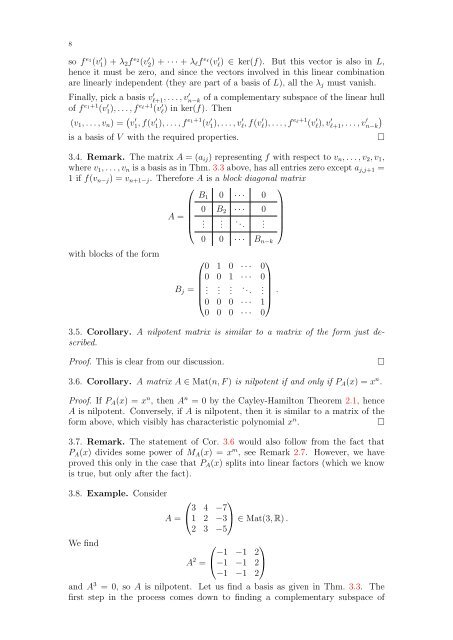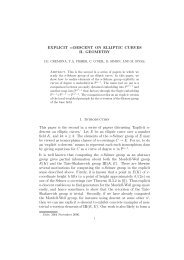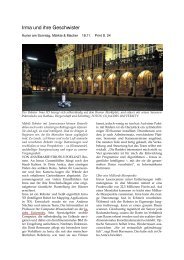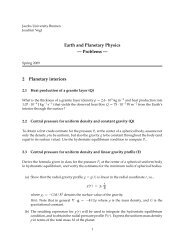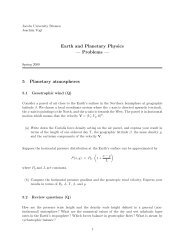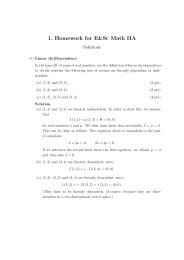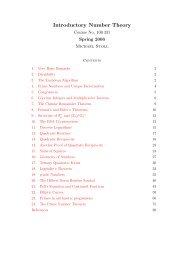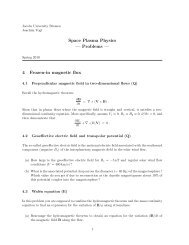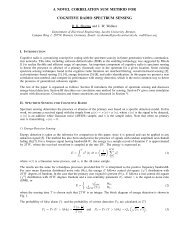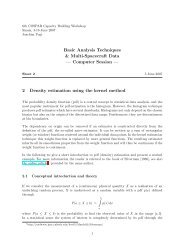Linear Algebra II (pdf, 500 kB)
Linear Algebra II (pdf, 500 kB)
Linear Algebra II (pdf, 500 kB)
Create successful ePaper yourself
Turn your PDF publications into a flip-book with our unique Google optimized e-Paper software.
8<br />
so f e1 ′ (v 1) + λ2f e2 ′ (v 2) + · · · + λℓf eℓ(v ′ ℓ ) ∈ ker(f). But this vector is also in L,<br />
hence it must be zero, and since the vectors involved in this linear combination<br />
are linearly independent (they are part of a basis of L), all the λj must vanish.<br />
Finally, pick a basis v ′ ℓ+1 , . . . , v′ n−k of a complementary subspace of the linear hull<br />
of f e1+1 ′ (v 1), . . . , f eℓ+1 ′ (v ℓ ) in ker(f). Then<br />
(v1, . . . , vn) = v ′ 1, f(v ′ 1), . . . , f e1+1 ′<br />
(v 1), . . . , v ′ ℓ, f(v ′ ℓ), . . . , f eℓ+1 ′<br />
(v ℓ), v ′ ℓ+1, . . . , v ′ <br />
n−k<br />
is a basis of V with the required properties. <br />
3.4. Remark. The matrix A = (aij) representing f with respect to vn, . . . , v2, v1,<br />
where v1, . . . , vn is a basis as in Thm. 3.3 above, has all entries zero except aj,j+1 =<br />
1 if f(vn−j) = vn+1−j. Therefore A is a block diagonal matrix<br />
⎛<br />
⎞<br />
B1 0 · · · 0<br />
⎜<br />
⎟<br />
⎜ 0 B2 · · · 0 ⎟<br />
A = ⎜<br />
⎟<br />
⎜ ...<br />
⎟<br />
⎝ . . . ⎠<br />
with blocks of the form<br />
0 0 · · · Bn−k<br />
⎛<br />
0 1 0 · · ·<br />
⎞<br />
0<br />
⎜0<br />
⎜<br />
Bj = ⎜<br />
⎜.<br />
⎝0<br />
0<br />
.<br />
0<br />
1<br />
.<br />
0<br />
· · ·<br />
.. .<br />
· · ·<br />
0 ⎟<br />
.<br />
⎟<br />
1⎠<br />
0 0 0 · · · 0<br />
.<br />
3.5. Corollary. A nilpotent matrix is similar to a matrix of the form just described.<br />
Proof. This is clear from our discussion. <br />
3.6. Corollary. A matrix A ∈ Mat(n, F ) is nilpotent if and only if PA(x) = x n .<br />
Proof. If PA(x) = x n , then A n = 0 by the Cayley-Hamilton Theorem 2.1, hence<br />
A is nilpotent. Conversely, if A is nilpotent, then it is similar to a matrix of the<br />
form above, which visibly has characteristic polynomial x n . <br />
3.7. Remark. The statement of Cor. 3.6 would also follow from the fact that<br />
PA(x) divides some power of MA(x) = x m , see Remark 2.7. However, we have<br />
proved this only in the case that PA(x) splits into linear factors (which we know<br />
is true, but only after the fact).<br />
3.8. Example. Consider<br />
⎛<br />
3<br />
A = ⎝1 4<br />
2<br />
⎞<br />
−7<br />
−3⎠<br />
∈ Mat(3, R) .<br />
2 3 −5<br />
We find<br />
A 2 ⎛<br />
−1<br />
= ⎝−1 −1<br />
−1<br />
⎞<br />
2<br />
2⎠<br />
−1 −1 2<br />
and A 3 = 0, so A is nilpotent. Let us find a basis as given in Thm. 3.3. The<br />
first step in the process comes down to finding a complementary subspace of


